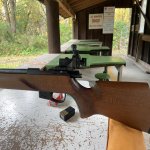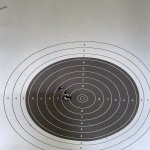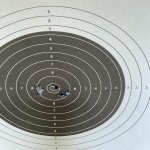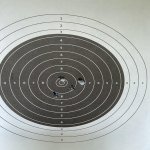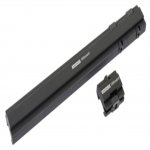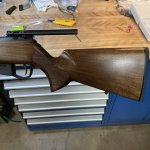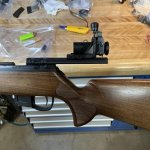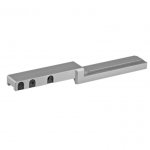Today, on the 50m rimfire range, I tested my new front sight Iris (MEC-CENTRA Standard Iris M18, 2.3 - 4.3). My rear sight rail extension and iris are en-route from Nordic Marksman, so today I tested just one new variable: the front sight iris aperture size.
Bench set-up as per post #1. (Ya I know, fully supported rifle on rest and bags, ho-hum, minimal skill. My Anschutz 1907 was made for positional shooting, gosh darn it! I will be evolving to classic positional shooting one day!

)
Weather conditions were near perfect: Wind varied from nil, to occaisional light breezes that I waited out based on the flags. I did get caught in one extended breeze that opened the group (more on that later). Sky was overcast and light was diffuse and dull, and no mirage.
Today's Ammo: SK Rifle Match ("Red"). My rifle likes the lot I have, but as with all SK ammo, you can expect variability out to about 1 MOA (out to about 0.5" at 50m), and a crazy random flier frequency at about 1 or 2 rounds per box of 50 on average. Today I think I had at least one of those fliers.
Target photos below are cropped, and stuck into pairs to reduce file size - in real life they have much more white space around them for the aperture ring.
Targets are the standard ISSF 50m. I shot 10 rounds per bull for score, but for results I also measured group size for fun. Take the score and X count with a grain of salt because the holes got ragged and chunks of paper got blown out, so for some it was difficult to estimate.
I started with iris at 3.6 for the first 3 targets because it looked about perfect for my eyes...at least at the start of the testing, so these were warm-ups before I started adjusting the iris up and down.
Target 1 iris at 3.6. Score = 96-2X. Group = 0.730"
Target 2 iris at 3.6. Score = 95-2X. Group = 1.159".
I am fairly sure the flier high right into the 8-7 line was a bad round and not me. No other rounds went into this sector of the targets.
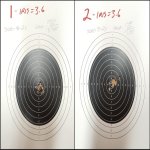
Target 3 iris at 3.6. Score = 99-3X. Group = 0.543"
(I mis-labled target 4 as 5, so there is no #4)
Target 5 iris at 3.0. Score = 97-1X. Group = 0.874"
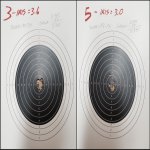
Target 6 iris at 3.2. Score = 100-5X. Group = 0.474"
Target 7 iris at 3.4. Score = 92-1X. Group = 0.960"
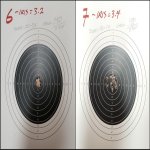
Target 8 iris at 4.0. Score = 96-6X. Group = 0.493"
Target 9 iris at 3.9. Score = 96-5X. Group = 0.641"
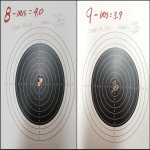
Target 10 iris at 3.8. Score = 95-4X. Group = 0.456"
Target 11 iris at 3.7. Score = 96-3X. Group = 0.802"
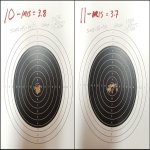
Target 12 iris at 3.6. Score = 97-3X. Group = 0.830"
The wind suddenly started to pick up here right to left, and it was impossible to wait it out. One round blew out left into the 8 ring. I clicked right 2 clicks (4mm), and the next round touched that on on the inside. I clicked one more (total 6mm right), and brought the next ones back right into the 9/10. The water line was very good except for one flier in the 9 high left.
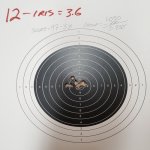 Discussion:
Discussion:
Wow, I continue to be amazed at how accurate one can shoot with aperture sights. Relying on the eye and brain to center something up that far away, and yet it works! I had 3 groups under 0.5 inches! I often cannot do that with my 45x45 Sightron target scope!
As experienced shooters have have mentioned, a common newbie (like me) error can be using an aperture too small, thinking a narrow white ring is more accurate. Some have stated start with 4.0 and stick with it unless something better works. Sure enough my 4.0 target #8 scored my highest X-count at 6X, and the 2nd smallest group at 0.493". But very interestingly, my best result was iris at 3.2, with score 100-5X, and 0.474" group. Second best score at 97-1X was with iris at 3.0, but X count was pathetically low and group (0.874") was mediocre.
Iris at 3.6 was over-represented in the test because with the light conditions, it looked the best to my eye, but perhaps that was a false impression, because that one test at 4.0 was darn good. If I had more time today, I would have shot more targets with the iris at 4.0.
Obviously nothing here is statistically significant because sample sizes are way too small, and wind although less of a factor today, did cause some variation.
I tried looking in the iris at 2.8, 2.9, but the white ring was quite dark and fuzzy, likely due to the dull overcast light.
The plastic insert kit I started with are the less expensive ones without a black metal ring insert around the aperture, and the plastic bevel makes a grayish, less contrasting ring. The front sight iris provides a jet-black very contrasty ring which I found superior to my plastic insert rings. The inserts are obviously good enough, but with one test I am sold on the advantages of the front sight iris.
10-shot groups are great for measuring group, but its too many for score due to the paper shredding and blow-out issue. For score I should change to 5-shot groups. Time to order more targets!
















































